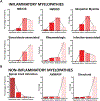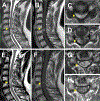Clinical Approach to Myelopathy Diagnosis
- PMID: 38330471
- PMCID: PMC11938100
- DOI: 10.1212/CON.0000000000001390
Clinical Approach to Myelopathy Diagnosis
Abstract
Objective: This article describes an integrative strategy to evaluate patients with suspected myelopathy, provides advice on diagnostic approach, and outlines the framework for the etiologic diagnosis of myelopathies.
Latest developments: Advances in diagnostic neuroimaging techniques of the spinal cord and improved understanding of the immune pathogenic mechanisms associated with spinal cord disorders have expanded the knowledge of inflammatory and noninflammatory myelopathies. The discovery of biomarkers of disease, such as anti-aquaporin 4 and anti-myelin oligodendrocyte glycoprotein antibodies involved in myelitis and other immune-related mechanisms, the emergence and identification of infectious disorders that target the spinal cord, and better recognition of myelopathies associated with vascular pathologies have expanded our knowledge about the broad clinical spectrum of myelopathies.
Essential points: Myelopathies include a group of inflammatory and noninflammatory disorders of the spinal cord that exhibit a wide variety of motor, sensory, gait, and sensory disturbances and produce major neurologic disability. Both inflammatory and noninflammatory myelopathies comprise a broad spectrum of pathophysiologic mechanisms and etiologic factors that lead to specific clinical features and presentations. Knowledge of the clinical variety of myelopathies and understanding of strategies for the precise diagnosis, identification of etiologic factors, and implementation of therapies can help improve outcomes.
Copyright © 2024 American Academy of Neurology.
Figures









References
MeSH terms
Substances
Grants and funding
LinkOut - more resources
Full Text Sources
Medical
